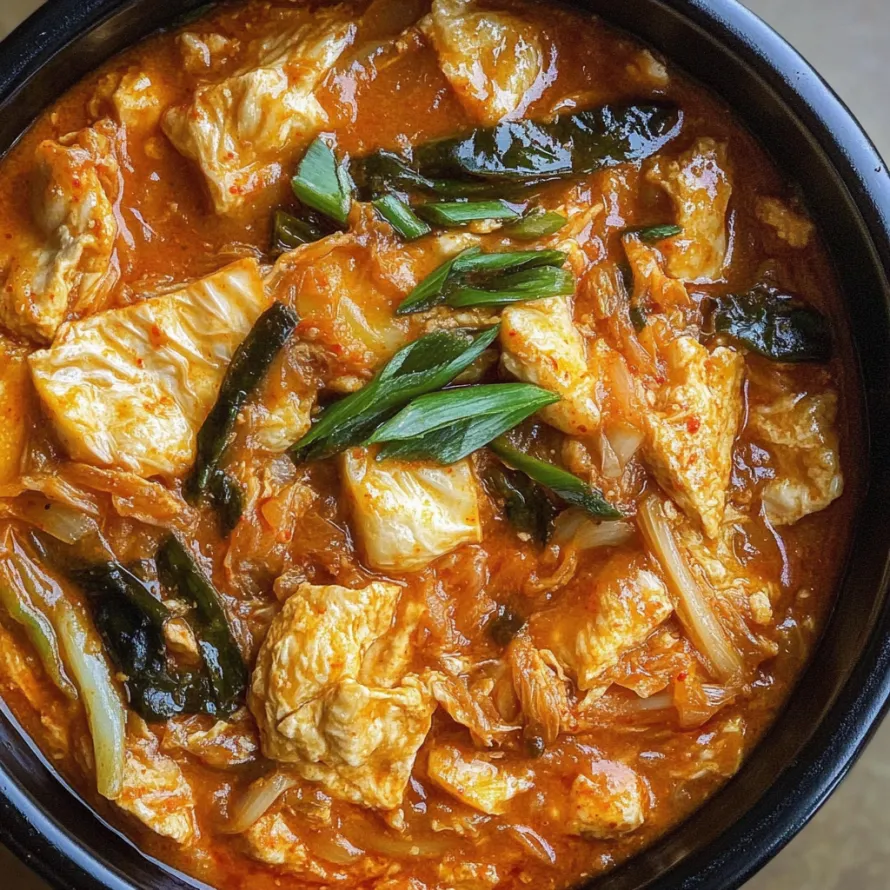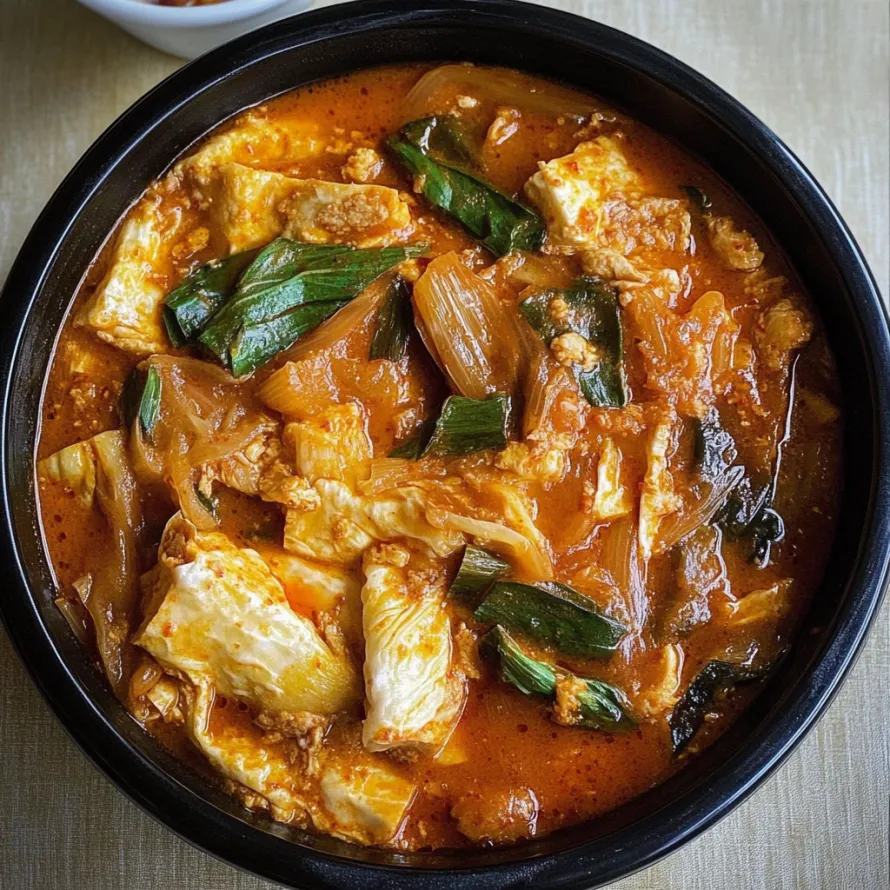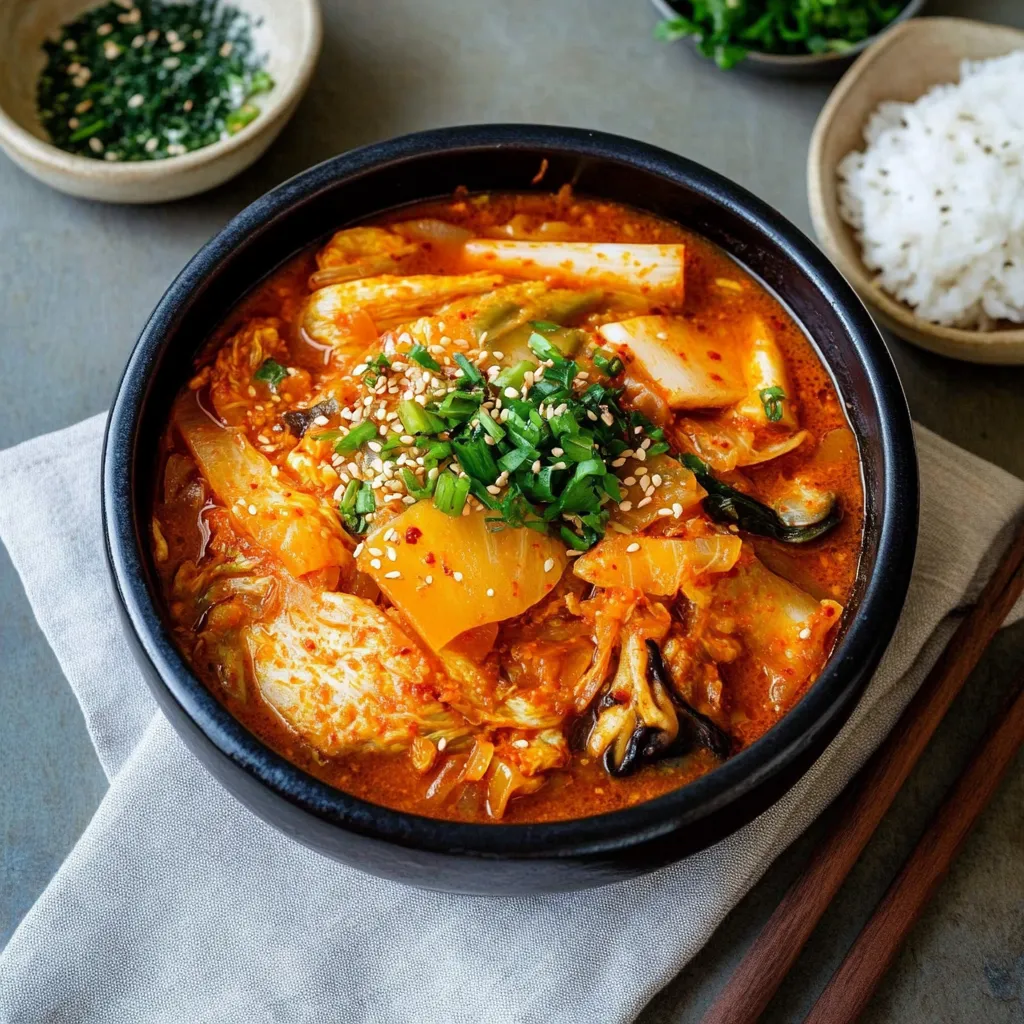 Pin it
Pin it
Kimchi jjigae (said like kimchi chigae) is where old kimchi really gets to shine. This classic Korean stew shows up on the table multiple times a week in lots of homes. It's that comforting, can’t-get-enough dinner that feels like wrapping up in your favorite blanket when it’s cold. Tangy kimchi brings its signature punch, blending into a bold broth with soft bites of meat for the kind of meal you just can’t stop eating.
I first had kimchi jjigae when my college roommate from Korea made a pot during a freezing winter. Our apartment filled up with the most mouthwatering smell as that bubbling stew cooked. I took one bite and finally understood why this humble meal is a huge deal in Korean homes. Even now, every time I fix it for my family, I think back to that memory, especially when we need something warm and cozy.
Mouthwatering Elements
- Tofu slabs: Soak up the flavorful stew and add a soft protein boost
- Shiitake mushrooms: Bring earthy notes and happily absorb the surrounding goodness
- Brown onions, sliced: They get sweet as they cook down, balancing out the kimchi’s acidity
- Gochujang (fermented chili paste): Makes everything thicker and gives that deep funky flavor you just can't replace
- Korean chili flakes: Add the classic reddish color and just-right level of heat
- Pork belly strips: Offer melt-in-your-mouth richness you won’t get from leaner cuts
- Aged kimchi: Packs in all the sour, spicy backbone the stew needs
- Sweet rice wine: Tenderizes pork and adds a little something extra to the mix
- Green onion chunks: Go in at the end for some pop and crunch, plus a splash of green
- Soy sauce (classic): Makes the whole thing richer and saltier in that uniquely savory way
- Fresh cracked pepper: Offers a mild heat that doesn’t overpower but keeps things interesting
Pork belly’s rich flavor and the sharp tang of old kimchi are what make this stew truly stand out. Tofu pieces soak up every drop of broth, while mushrooms double down on the umami. Pick up quality stuff when you can because it makes every bite warmer and deeper in taste.
Simple Stew Steps
- Getting started with the flavor mix:
- In a little bowl, toss together soy sauce, Korean chili flakes, gochujang, some chopped garlic, and a dash of black pepper. Stir until you’ve got a smooth, blended paste. Spread this right over your uncooked stew, but don’t mix it in—all those flavors will sneak in as the pot simmers.
- Bringing it all together in the pot:
- Lay out your marinated pork right on the bottom of a big, heavy pot or a Korean earthenware bowl. Cover with softened kimchi. Sprinkle on the onions, pile mushrooms and tofu on top, and then pour enough saved kimchi juice and water until stuff is mostly covered.
- Cooking rhythm:
- Crank up to medium-high and wait until it’s bubbling. Don’t mess with it yet! Once it’s rolling, drop the heat to medium and let it go for about fifteen minutes, uncovered. Use a big spoon to ladle broth over anything poking out so nothing dries up. Just before you’re done—two minutes out—add your green onion and mix gently.
- Making the kimchi pop:
- While the pork relaxes in the marinade, chop up your old kimchi. Keep both the leafy bits and the thick stems—they each add something different. Drain off spare liquid to use later. Toss the kimchi into a hot pan (no oil), and cook until it softens up and the oils become nice and bright. This step helps wake up all the best flavors.
- Pork prep:
- Chop pork belly (skin off) into half-inch pieces so they cook evenly. Toss it all in a bowl with sweet rice wine and lots of cracked pepper—get each slice coated. Mix it up by hand and let it chill for fifteen minutes while you do the kimchi. That gives the wine enough time to work its magic and make the meat nice and tender.
 Pin it
Pin it
Except for kimchi, gochujang is the one thing I refuse to skimp on. My grandma always swore by making hers by hand in big jars stored outdoors. I usually grab a quality jar from the store, but once in a while, I treat myself to the really good, small-batch stuff that takes me right back to her sunny little kitchen in Seoul.
Serving Ideas
Make your kimchi jjigae shine by plating it with all the right extras. Scoop up fluffy, freshly steamed short-grain rice to soak up every last drop. Lay out a few banchan sides, like pickled cucumbers or sesame-oil blanched spinach, to add a fresh bite. Dishes of pickled radish or some sweet-sour bean sprouts bring crunch and make the whole spread feel complete and true to Korean dining.
Keep It Fresh
Cool off the jjigae completely before moving it into glass containers with tight lids, since plastic can pick up the color and flavor strong stew leaves behind. Pop everything into the fridge fast and finish it up within four days. You’ll actually notice it tastes even better a day later after the flavors blend together even more.
 Pin it
Pin it
This kimchi jjigae has come with me from tiny dorm kitchens to family parties, and somehow it feels even more special every time. Bringing together juicy pork, tangy kimchi, and old-school Korean flavors, it’s more than just a meal—it keeps stories, memories, and laughter alive across generations.
Frequently Asked Questions
- → Is it okay to use fresh kimchi instead of old kimchi?
- Older kimchi (over 2 weeks old) gives you the tastiest kimchi jjigae. Fresh kimchi works too—just splash in some lemon juice or white vinegar, about 1-2 teaspoons, to bring out that tang.
- → How do I make a vegetarian kimchi jjigae?
- Skip the pork belly and make sure you’ve got vegetarian kimchi (no fish sauce in it). Go ahead and add firm tofu or extra mushrooms, and maybe a glug of veggie oil for that nice rich feel.
- → What if I can’t get my hands on gochujang?
- If gochujang is out of reach, try mixing two parts sriracha, one part miso, and a little sugar together. It’s not exactly the same but brings the right heat and some depth.
- → Which sides go best with kimchi jjigae?
- Go for steamed rice, cool spicy cucumbers (oi muchim), soft bean sprouts (kongnamul muchim), or melt-in-your-mouth soy potatoes (gamja jorim). All match up great.
- → How long will extra kimchi jjigae last in the fridge?
- Stash leftover stew in a sealed container in your fridge—it's good for about 3 days. The flavor actually gets deeper after a night or two.
